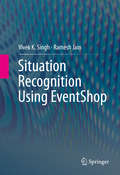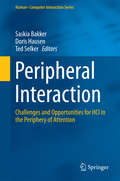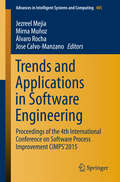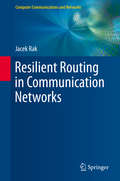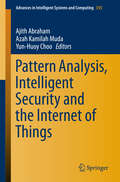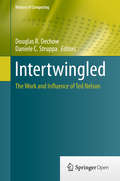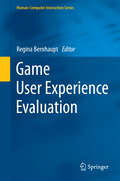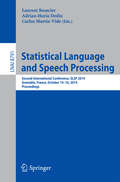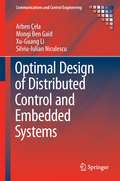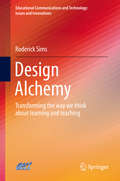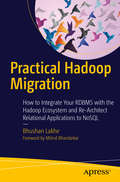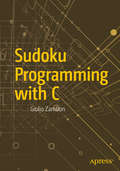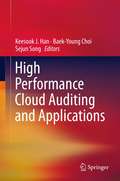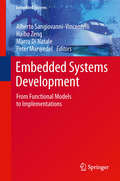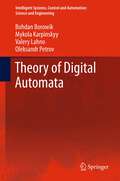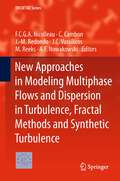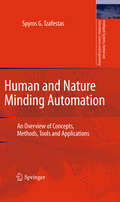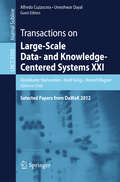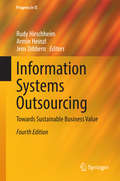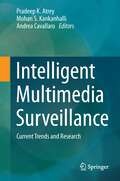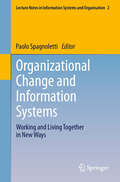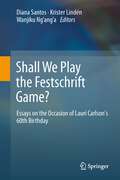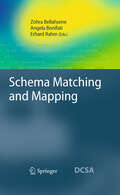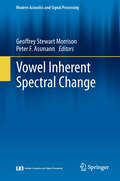- Table View
- List View
Situation Recognition Using EventShop
by Ramesh Jain Vivek K. SinghThis book presents a framework for converting multitudes of data streams available today including weather patterns, stock prices, social media, traffic information, and disease incidents into actionable insights based on situation recognition. It computationally defines the notion of situations as an abstraction of millions of data points into actionable insights, describes a computational framework to model and evaluate such situations and presents an open-source web-based system called EventShop to implement them without necessitating programming expertise. The book is useful for both practitioners and researchers working in the field of situation-aware computing. It acts as a primer for data-enthusiasts and information professionals interested in harnessing the value of heterogeneous big data for building diverse situation-based applications. It also can be used as a reference text by researchers working in areas as varied as database design, multimodel concept recognition, and middle-ware and ubiquitous computing to design and develop frameworks that allow users to create their own situation recognition frameworks.
Peripheral Interaction
by Saskia Bakker Doris Hausen Ted SelkerComputing devices havebecome ever more present in our everyday environments, however embedding thesetechnologies into our routines has remained a challenge. This book exploresthe novel theory of peripheral interaction to rectify this. This theory examines how interactivesystems canbe developed in such a way to allow people to seamlessly interact withtheir computer devices, but only focus on them at relevant times, building onthe way in which people effortlessly divide their attention over severaleveryday activities in day to day life. Capturing the currentstate of the art within the field, this book explores the history and foundationaltheories of peripheral interaction, discussesnovel interactive styles suitable for peripheral interaction, addressesdifferent application domains which can benefit from peripheral interaction andpresents visions of how thesedevelopments can have a positive impact on our future lives. As such, thisbook's aim is to contribute to research and practice in fields such ashuman-computer interaction, ubiquitous computing and Internet of Things, a viewon how interactive technology could be redesigned to form a meaningful, yetunobtrusive part of people's everyday lives. Peripheral Interaction will be highly beneficial to researchers anddesigners alike in areas such as HCI, Ergonomics and Interaction Design.
Trends and Applications in Software Engineering
by Jezreel Mejia Mirna Munoz Álvaro Rocha Jose Calvo-ManzanoThis book contains a selection of papers from The 2015 International Conference on Software Process Improvement (CIMPS'15), held between the 28th and 30th of October in Mazatlán, Sinaloa, México. The CIMPS'15 is a global forum for researchers and practitioners that present and discuss the most recent innovations, trends, results, experiences and concerns in the several perspectives of Software Engineering with clear relationship but not limited to software processes, Security in Information and Communication Technology and Big Data Field. The main topics covered are: Organizational Models, Standards and Methodologies, Knowledge Management, Software Systems, Applications and Tools, Information and Communication Technologies and Processes in non-software domains (Mining, automotive, aerospace, business, health care, manufacturing, etc. ) with a demonstrated relationship to software process challenges.
Resilient Routing in Communication Networks
by Jacek RakThis important text addresses the latest issues in end-to-end resilient routing in communication networks. The work highlights the main causes of failures of network nodes and links, and presents an overview of resilient routing mechanisms, covering issues related to the Future Internet (FI), wireless mesh networks (WMNs), and vehicular ad-hoc networks (VANETs). Features: discusses FI architecture for network virtualization; introduces proposals for dedicated and shared protection in random failure scenarios and against malicious activities; describes measures for WMN survivability that allow for evaluation of performance under multiple failures; proposes a new scheme to enable proactive updates of WMN antenna alignment; includes a detailed analysis of the differentiated reliability requirements for VANET applications, with a focus on issues of multihop data delivery; reviews techniques for improving the stability of end-to-end VANET communication paths based on multipath routing and anycast forwarding.
Pattern Analysis, Intelligent Security and the Internet of Things
by Ajith Abraham Azah Kamilah Muda Yun-Huoy ChooThis Volume presents the selected papers from the 5 Parallel Symposiums of the 2014 Fourth World Congress on Information and Communication Technologies (WICT 2014) held in Malacca, Malaysia. The theme of WICT 2014 'Innovating ICT for Social Revolutions'. WICT 2014 is Co-Organized by Machine Intelligence Research Labs (MIR Labs), USA and Universiti Teknikal Malaysia Melaka, Malaysia. WICT 2014 is technically co-sponsored by IEEE Systems, Man & Cybernetics Society Malaysia and Spain Chapters and Technically Supported by IEEE Systems Man and Cybernetics Society, Technical Committee on Soft Computing.
Intertwingled
by Daniele C. Struppa Douglas R. DechowThis engaging volume celebrates the life and work of Theodor Holm "Ted" Nelson, a pioneer and legendary figure from the history of early computing. Presenting contributions from world-renowned computer scientists and figures from the media industry, the book delves into hypertext, the docuverse, Xanadu and other products of Ted Nelson's unique mind. Features: includes a cartoon and a sequence of poems created in Nelson's honor, reflecting his wide-ranging and interdisciplinary intellect; presents peer histories, providing a sense of the milieu that resulted from Nelson's ideas; contains personal accounts revealing what it is like to collaborate directly with Nelson; describes Nelson's legacy from the perspective of his contemporaries from the computing world; provides a contribution from Ted Nelson himself. With a broad appeal spanning computer scientists, science historians and the general reader, this inspiring collection reveals the continuing influence of the original visionary of the World Wide Web.
Game User Experience Evaluation
by Regina BernhauptEvaluating interactive systems for their user experience (UX) is a standard approach in industry and research today. This book explores the areas of game design and development and Human Computer Interaction (HCI) as ways to understand the various contributing aspects of the overall gaming experience. Fully updated, extended and revised this book is based upon the original publication Evaluating User Experience in Games, and provides updated methods and approaches ranging from user- orientated methods to game specific approaches. New and emerging methods and areas explored include physiologically- orientated UX evaluation, user behaviour, telemetry based methods and social play as effective evaluation techniques for gaming design and evolving user-experience. Game User Experience Evaluation allows researchers, PhD students as well as game designers and developers to get an overview on available methods for all stages of the development life cycle.
Statistical Language and Speech Processing
by Carlos Martín-Vide Adrian-Horia Dediu Laurent BesacierThis book constitutes the refereed proceedings of the Second International Conference on Statistical Language and Speech Processing, SLSP 2014, held in Grenoble, France, in October 2014. The 18 full papers presented together with three invited talks were carefully reviewed and selected from 53 submissions. The papers are organized in topical sections on machine translation, speech and speaker recognition, machine learning methods, text extraction and categorization, and mining text.
Optimal Design of Distributed Control and Embedded Systems
by Silviu-Iulian Niculescu Xu-Guang Li Arben Çela Mongi Ben GaidOptimal Design of Distributed Control and Embedded Systems focuses on the design of special control and scheduling algorithms based on system structural properties as well as on analysis of the influence of induced time-delay on systems performances. It treats the optimal design of distributed and embedded control systems (DCESs) with respect to communication and calculation-resource constraints, quantization aspects, and potential time-delays induced by the associated communication and calculation model. Particular emphasis is put on optimal control signal scheduling based on the system state. In order to render this complex optimization problem feasible in real time, a time decomposition is based on periodicity induced by the static scheduling is operated. The authors present a co-design approach which subsumes the synthesis of the optimal control laws and the generation of an optimal schedule of control signals on real-time networks as well as the execution of control tasks on a single processor. The authors also operate a control structure modification or a control switching based on a thorough analysis of the influence of the induced time-delay system influence on stability and system performance in order to optimize DCES performance in case of calculation and communication resource limitations. Although the richness and variety of classes of DCES preclude a completely comprehensive treatment or a single "best" method of approaching them all, this co-design approach has the best chance of rendering this problem feasible and finding the optimal or some sub-optimal solution. The text is rounded out with references to such applications as car suspension and unmanned vehicles. Optimal Design of Distributed Control and Embedded Systems will be of most interest to academic researchers working on the mathematical theory of DCES but the wide range of environments in which they are used also promotes the relevance of the text for control practitioners working in the avionics, automotive, energy-production, space exploration and many other industries.
Design Alchemy
by Roderick SimsThe promise of online learning--flexible, learner-centered, responsive--was forward-looking and poised to revolutionize education. But too often online learning courses have little room for student engagement and their design does not reflect the potential for interactive and collaborative learning. Design Alchemy counters this trend by synthesizing the art and science of educational design to model a whole that transcends the sum of its parts. Challenging yet accessible, it clearly sets out steps for harnessing innovative strategies and designer creativity to provide educational platforms that reduce learner boredom and instructor burnout, and encourage deeper interaction with subject matter. Activities, assessment methods, and sample course materials are designed toward improving quality, embracing diversity, and adapting positively to change. And the book's palette of resources enables readers to effectively apply the principles in their own practice: The evolution of Design Alchemy in the context of online learning. Alignment with core theories and practice models. The framework: elements of pedagogy and components of practice. Case studies showing Design Alchemy in real-world learning. Tools, templates, and a sample syllabus. The Design Alchemy Manifesto, summarizing key ideas. Researchers and practitioners in technology and education will look to Design Alchemy as a transformative work to help make the most of student potential, learning opportunities, and their own professional growth.
Practical Hadoop Migration
by Bhushan LakhePractical Hadoop Migration shows database developers, database administrators, enterprise architects, and IT leaders how to re-architect relational applications to NoSQL, integrate relational database management systems with the Hadoop ecosystem, and transform and migrate relational data to and from Hadoop components. Winner of IBM's 2012 Gerstner Award for his implementation of big data and data warehouse initiatives and author of Practical Hadoop Security, author Bhushan Lakhe walks you through the entire transition process. First, he lays out the criteria for deciding what blend of re-architecting, migration, and integration between RDBMS and HDFS best meets your transition objectives. Then he demonstrates how to design your transition model. He covers the best-practice design approaches to re-architecting your relational applications and transforming your relational data to optimize concurrency, security, denormalization, and performance in their NoSQL targets. Lakhe proceeds to cover the selection criteria for ETL tools, the implementation steps for migration with SQOOP- and Flume-based data transfers, and transition optimization techniques for tuning partitions, scheduling aggregations, and redesigning ETL. Finally, he assesses the pros and cons of data lakes and Lambda architecture as integrative solutions and illustrates their implementation with real-world case studies. Hadoop/NoSQL solutions do not offer by default cer tain relational technology features such as role-based access control, locking for concurrent updates, and various tools for measuring and enhancing performance. Practical Hadoop Migration shows how to use open-source tools to emulate such relational functionalities in Hadoop ecosystem components.
Sudoku Programming with C
by Giulio ZambonLearn how to write computer programs to solve and generate Sudoku puzzles. In Sudoku Programming with C, you will discover every solving strategy and the code to implement them. This practical book provides you with everything you need to write your own books of Sudoku Classic and Samurai puzzles. But be warned: after reading it, you'll discover that the puzzles in your local paper are not so challenging after all! We like Sudokus because they test our capacity to recognize and interpret patterns. But how are the clues generated? Where do those quasi-symmetrical configurations come from? When the author explored the Web to find out, he discovered that there were many sites that explained how to solve Sudokus, but none that told him how create them. He also saw many sites and apps to play Sudoku, but, perhaps not surprising, no indication of how they worked. So, he had to develop his own applications in order to find out. And, from the very start, he decided that he would publish the code for anyone else to use and perhaps tinker with, but the author wrote it in such a way that also lets readers with limited knowledge of programming techniques understand it. In fact, you could decide to start generating thousands of puzzles almost immediately, and go through the explanations of algorithms and techniques later, a bit at a time. The author chose to write the application in 'plain old C' because he wanted to make the code accessible to as many people as possible. In this book, you will find an explanation of all solving strategies, and the code to implement them. Writing the Solver application was more difficult than writing the Generator, because it required designing and implementing each strategy separately. However, the author wanted to include a solving program capable of listing the strategies necessary to solve any particular puzzle. He also wanted to check whether a puzzle was solvable analytically, without any guessing. This book includes the full listings of both the Generator and the Solver, and explanations of all C modules, with walk-throughs and examples. What you'll learn How to model a Sudoku puzzle in C What are the strategies in the main program as well as in the utilities needed How to implement numerous strategies and techniques for Sudoku generating and solving How to solve puzzles How to generate Sudokus What are Samurai Sudokus and how to solve them Who this book is for This book is for readers with limited knowledge of programming techniques. The C code is significant and so it is best to have some prior knowledge of C. Table of Contents 1. Modelling a Sudoku Puzzle in C 2. The Strategies 3. Main Program and Utilities 4. Implementing 'unique' 5. Implementing 'naked' Strategies 6. Implementing 'hidden' Strategies 7. Implementing 'box-line' 8. Implementing 'pointing-line' 9. Implementing 'lines' Strategies 10. Implementing 'Y-wing' 11. Implementing 'XY-chain' 12. Implementing 'rectangle' 13. Implementing 'backtrack' 14. Solving Thousands of Puzzles 15. Generating Sudokus 16. Puzzle Statistics 17. Puzzles 18. Samurai Sudokus A. Eclipse CDT B. Puzzle Solutions C. Abbreviations and Acronyms D. Strategy Index
High Performance Cloud Auditing and Applications
by Keesook J. Han Baek-Young Choi Sejun SongThis book mainly focuses on cloud security and high performance computing for cloud auditing. The book discusses emerging challenges and techniques developed for high performance semantic cloud auditing, and presents the state of the art in cloud auditing, computing and security techniques with focus on technical aspects and feasibility of auditing issues in federated cloud computing environments. In summer 2011, the United States Air Force Research Laboratory (AFRL) CyberBAT Cloud Security and Auditing Team initiated the exploration of the cloud security challenges and future cloud auditing research directions that are covered in this book. This work was supported by the United States government funds from the Air Force Office of Scientific Research (AFOSR), the AFOSR Summer Faculty Fellowship Program (SFFP), the Air Force Research Laboratory (AFRL) Visiting Faculty Research Program (VFRP), the National Science Foundation (NSF) and the National Institute of Health (NIH). All chapters were partially supported by the AFOSR Information Operations and Security Program extramural and intramural funds (AFOSR/RSL Program Manager: Dr. Robert Herklotz). Key Features: · Contains surveys of cyber threats and security issues in cloud computing and presents secure cloud architectures · Presents in-depth cloud auditing techniques, federated cloud security architectures, cloud access control models, and access assured information sharing technologies · Outlines a wide range of challenges and provides solutions to manage and control very large and complex data sets
Embedded Systems Development: From Functional Models to Implementations
by Alberto Sangiovanni-Vincentelli Haibo Zeng Marco Di Natale Peter MarwedelThis book offers readers broad coverage of techniques to model, verify and validate the behavior and performance of complex distributed embedded systems. The authors attempt to bridge the gap between the three disciplines of model-based design, real-time analysis and model-driven development, for a better understanding of the ways in which new development flows can be constructed, going from system-level modeling to the correct and predictable generation of a distributed implementation, leveraging current and future research results.
Theory of Digital Automata
by Oleksandr Petrov Mykola Karpinskyy Bohdan Borowik Valery LahnoThis book serves a dual purpose: firstly to combine the treatment of circuits and digital electronics, and secondly, to establish a strong connection with the contemporary world of digital systems. The need for this approach arises from the observation that introducing digital electronics through a course in traditional circuit analysis is fast becoming obsolete. Our world has gone digital. Automata theory helps with the design of digital circuits such as parts of computers, telephone systems and control systems. A complete perspective is emphasized, because even the most elegant computer architecture will not function without adequate supporting circuits. The focus is on explaining the real-world implementation of complete digital systems. In doing so, the reader is prepared to immediately begin design and implementation work. This work serves as a bridge to take readers from the theoretical world to the everyday design world where solutions must be complete to be successful.
New Approaches in Modeling Multiphase Flows and Dispersion in Turbulence, Fractal Methods and Synthetic Turbulence
by J. M. Redondo A. F. Nowakowski C. Cambon F.C.G.A. Nicolleau J. C. Vassilicos M. ReeksThis book contains a collection of the main contributions from the first five workshops held by Ercoftac Special Interest Group on Synthetic Turbulence Models (SIG42. It is intended as an illustration of the sig's activities and of the latest developments in the field. This volume investigates the use of Kinematic Simulation (KS) and other synthetic turbulence models for the particular application to environmental flows. This volume offers the best syntheses on the research status in KS, which is widely used in various domains, including Lagrangian aspects in turbulence mixing/stirring, particle dispersion/clustering, and last but not least, aeroacoustics. Flow realizations with complete spatial, and sometime spatio-temporal, dependency, are generated via superposition of random modes (mostly spatial, and sometime spatial and temporal, Fourier modes), with prescribed constraints such as: strict incompressibility (divergence-free velocity field at each point), high Reynolds energy spectrum. Recent improvements consisted in incorporating linear dynamics, for instance in rotating and/or stably-stratified flows, with possible easy generalization to MHD flows, and perhaps to plasmas. KS for channel flows have also been validated. However, the absence of "sweeping effects" in present conventional KS versions is identified as a major drawback in very different applications: inertial particle clustering as well as in aeroacoustics. Nevertheless, this issue was addressed in some reference papers, and merits to be revisited in the light of new studies in progress.
Human and Nature Minding Automation
by Spyros G. TzafestasThis book examines the "symbiosis" of automation and technology with the human and the nature towards the ultimate goal of assuring global sustainability. Throughout the years a variety of approaches, technologies and practices have been produced in the direction of achieving human-and nature-minding automation and industrial activity. In this book an attempt is made, for the first time, to present in a cohesive and consolidated way an overview of all these issues together, and show how they combine to provide human-and nature-minding (green) systems. Human-minding automation is possible by employing concepts and techniques from the human factors and ergonomics fields, including job satisfaction, human-friendly interfaces, and human values, whereas nature-minding industrial activity and human development can be achieved by considering as a whole the human, economic, natural and cultural resources in the short and long term. In particular, nature-minding design selects the production methods and technologies that have the minimum impact to the nature. The book is intended for use both as a free reference conceptual book, and as general introductory book in relevant teaching and research environments.
Transactions on Large-Scale Data- and Knowledge-Centered Systems XXI
by Abdelkader Hameurlain Josef Küng Roland Wagner Umeshwar Dayal Alfredo CuzzocreaThe LNCS journal Transactions on Large-Scale Data- and Knowledge-Centered Systems focuses on data management, knowledge discovery, and knowledge processing, which are core and hot topics in computer science. Since the 1990s, the Internet has become the main driving force behind application development in all domains. An increase in the demand for resource sharing across different sites connected through networks has led to an evolution of data- and knowledge-management systems from centralized systems to decentralized systems enabling large-scale distributed applications providing high scalability. Current decentralized systems still focus on data and knowledge as their main resource. Feasibility of these systems relies basically on P2P (peer-to-peer) techniques and the support of agent systems with scaling and decentralized control. Synergy between grids, P2P systems, and agent technologies is the key to data- and knowledge-centered systems in large-scale environments. This volume, the 21st issue of Transactions on Large-Scale Data- and Knowledge-Centered Systems, focuses on Data Warehousing and Knowledge Discovery from Big Data, and contains extended and revised versions of eight papers selected as the best papers from the 14th International Conference on Data Warehousing and Knowledge Discovery (DaWaK 2012), held in Vienna, Austria, during September 3-6, 2012. These papers cover several advanced Big Data topics, ranging from data cube computation using MapReduce to multiple aggregations over multidimensional databases, from data warehousing systems over complex energy data to OLAP-based prediction models, from extended query engines for continuous stream analytics to popular pattern mining, and from rare pattern mining to enhanced knowledge discovery from large cross-document corpora.
Information Systems Outsourcing
by Rudy Hirschheim Armin Heinzl Jens DibbernThis book attempts to synthesize research that contributes to a better understanding of how to reach sustainable business value through information systems (IS) outsourcing. Important topics in this realm are how IS outsourcing can contribute to innovation, how it can be dynamically governed, how to cope with its increasing complexity through multi-vendor arrangements, how service quality standards can be met, how corporate social responsibility can be upheld and how to cope with increasing demands of internationalization and new sourcing models, such as crowdsourcing and platform-based cooperation. These issues are viewed from either the client or vendor perspective, or both. The book should be of interest to all academics and students in the fields of Information Systems, Management and Organization as well as corporate executives and professionals who seek a more profound analysis and understanding of the underlying factors and mechanisms of outsourcing.
Intelligent Multimedia Surveillance
by Andrea Cavallaro Pradeep K. Atrey Mohan S. KankanhalliIntelligent multimedia surveillance concerns the analysis of multiple sensing inputs including video and audio streams, radio-frequency identification (RFID), and depth data. These data are processed for the automated detection and tracking of people, vehicles, and other objects. The goal is to locate moving targets, to understand their behavior, and to detect suspicious or abnormal activities for crime prevention. Despite its benefits, there is societal apprehension regarding the use of such technology, so an important challenge in this research area is to balance public safety and privacy. This edited book presents recent findings in the field of intelligent multimedia surveillance emerging from disciplines such as multimedia computing, computer vision, and artificial intelligence. It consists of nine chapters addressing intelligent video surveillance, video analysis of crowds, privacy issues in intelligent multimedia surveillance, RFID technology for localization of objects, object tracking using visual saliency information, estimating multiresolution depth using active stereo vision, and performance evaluation for video surveillance systems. The book will be of value to researchers and practitioners working on related problems in security, multimedia, and artificial intelligence.
Organizational Change and Information Systems: Working and Living Together in New Ways
by Paolo SpagnolettiThis book examines a range of issues emerging from the interaction of Information Technologies and organizational systems. It contains a collection of research papers focusing on themes of growing interest in the field of Information Systems, Organization Studies, and Management. The book offers a multidisciplinary view on Information Systems aiming to disseminate academic knowledge. It might be particularly relevant to IT practitioners such as information systems managers, business managers and IT consultants. The volume is divided into six sections, each one focusing on a specific theme. The content of each section is based on a selection of the best papers (original double blind peer reviewed contributions) presented at the annual conference of the Italian chapter of AIS, which has been held in Rome, Italy in September 2012.
Shall We Play the Festschrift Game?
by Krister Lindén Diana Santos Wanjiku Ng’ang’aThere are not many people who can be said to have influenced and impressed researchers in so many disparate areas and language-geographic fields as Lauri Carlson, as is evidenced in the present Festschrift. His insight and acute linguistic sensitivity and linguistic rationality have spawned findings and research work in many areas, from non-standard etymology to hardcore formal linguistics, not forgetting computational areas such as parsing, terminological databases, and, last but not least, machine translation. In addition to his renowned and widely acknowledged insights in tense and aspect and its relationship with nominal quantification, and his ground-breaking work in dialog using game-theoretic machinery, Lauri has in the last fifteen years as Professor of Language Theory and Translation Technology contributed immensely to areas such as translation, terminology and general applications of computational linguistics. The three editors of the present volume have successfully performed doctoral studies under Lauri's supervision, and wish with this volume to pay tribute to his supervision and to his influence in matters associated with research and scientific, linguistic and philosophical inquiry, as well as to his humanity and friendship.
The Crossing of Heaven
by Karl Gustafson Ioannis AntoniouAmong the group of physics honors students huddled in 1957 on a Colorado mountain watching Sputnik bisect the heavens, one young scientist was destined, three short years later, to become a key player in America's own top-secret spy satellite program. One of our era's most prolific mathematicians, Karl Gustafson was given just two weeks to write the first US spy satellite's software. The project would fundamentally alter America's Cold War strategy, and this autobiographical account of a remarkable academic life spent in the top flight tells this fascinating inside story for the first time. Gustafson takes you from his early pioneering work in computing, through fascinating encounters with Nobel laureates and Fields medalists, to his current observations on mathematics, science and life. He tells of brushes with death, being struck by lightning, and the beautiful women who have been a part of his journey.
Schema Matching and Mapping
by Erhard Rahm Angela Bonifati Zohra BellahseneSchema Matching and Mapping provides an overview of the ways in which the schema and ontology matching and mapping tools have addressed information systems requirements. Topics include effective methods for matching data, mapping transformation verification, mapping-driven schema evolution and merging.
Vowel Inherent Spectral Change
by Geoffrey Stewart Morrison Peter F. AssmannIt has been traditional in phonetic research to characterize monophthongs using a set of static formant frequencies, i.e., formant frequencies taken from a single time-point in the vowel or averaged over the time-course of the vowel. However, over the last twenty years a growing body of research has demonstrated that, at least for a number of dialects of North American English, vowels which are traditionally described as monophthongs often have substantial spectral change. Vowel inherent spectral change has been observed in speakers' productions, and has also been found to have a substantial effect on listeners' perception. In terms of acoustics, the traditional categorical distinction between monophthongs and diphthongs can be replaced by a gradient description of dynamic spectral patterns. This book includes chapters addressing various aspects of vowel inherent spectral change (VISC), including theoretical and experimental studies of the perceptually relevant aspects of VISC, the relationship between articulation (vocal-tract trajectories) and VISC, historical changes related VISC, cross-dialect, cross-language, and cross-age-group comparisons of VISC, the effects of VISC on second-language speech learning, and the use of VISC in forensic voice comparison.
